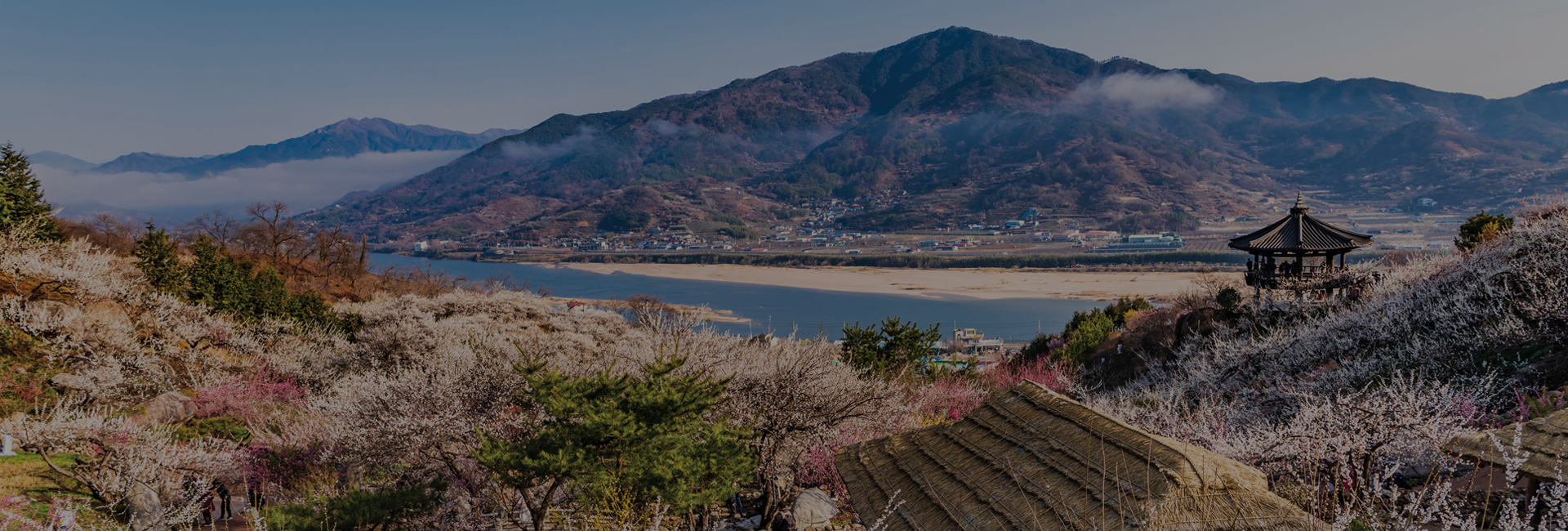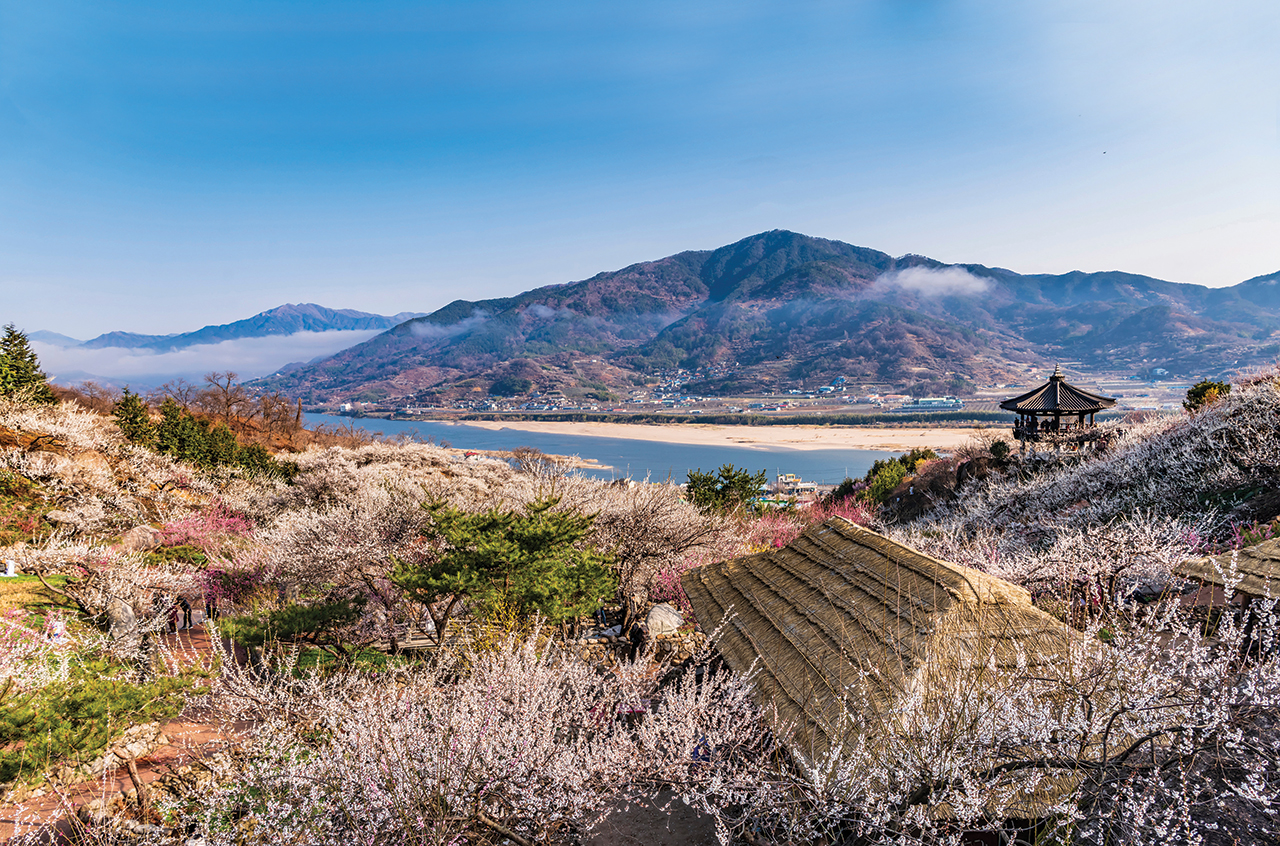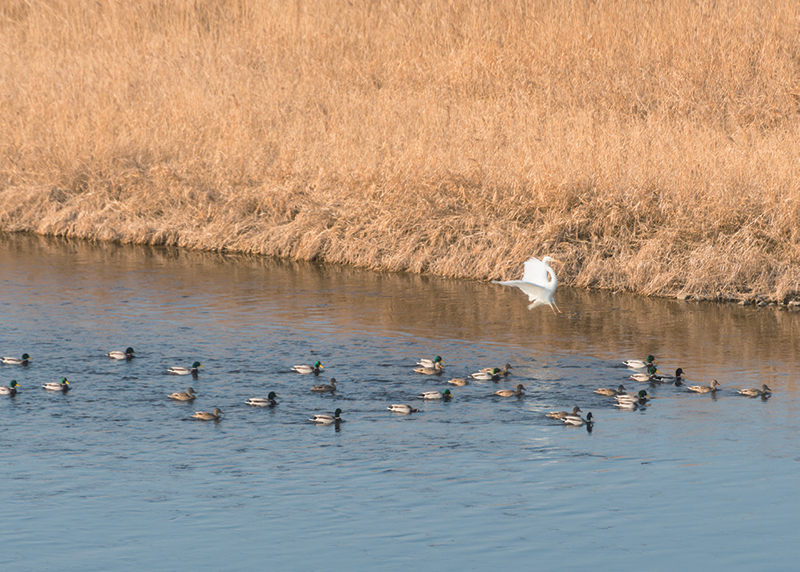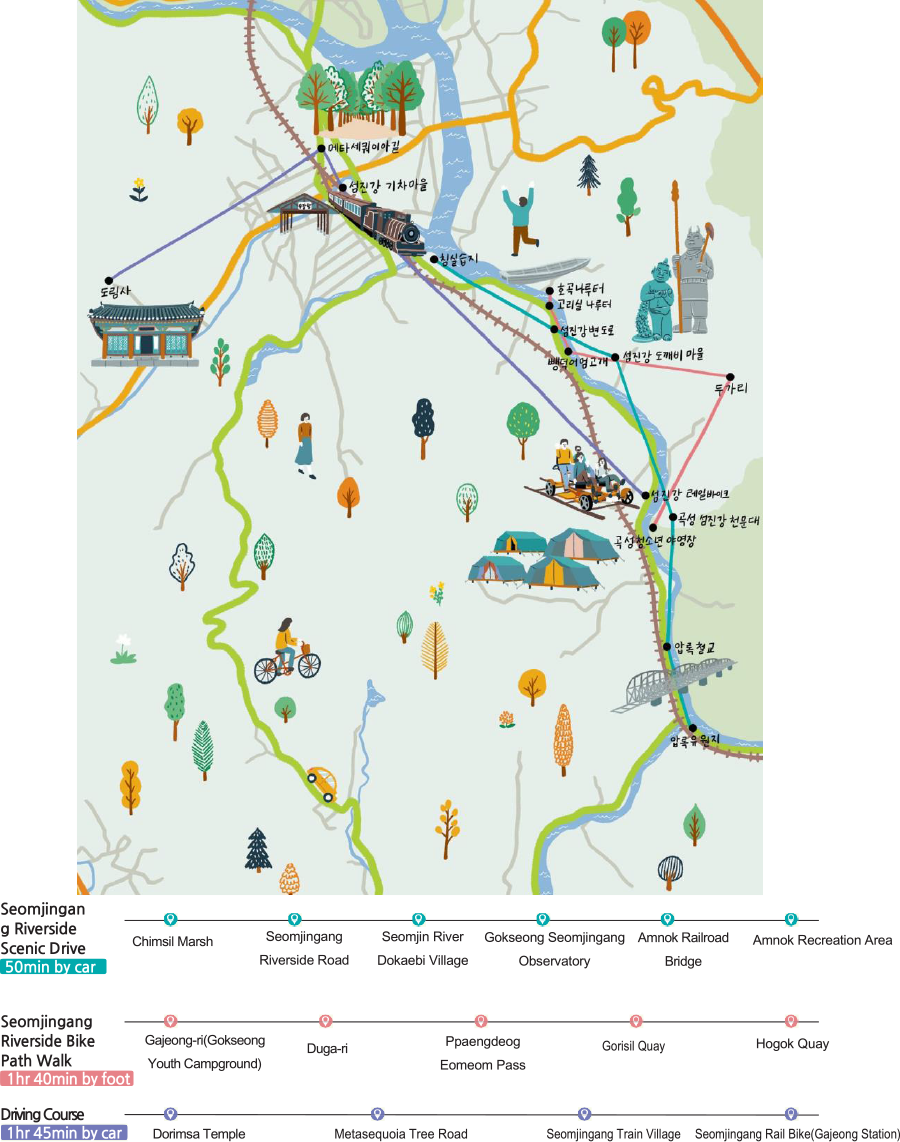
- Water, Nature and Humankind
- Travel for Save the Earth
-
‘National Wetland Protection Area’
Chimsil Marsh in
Gokseong
The marsh looks ever more
praiseworthy and attractive- Text and photo by. Lee Si-mok(travel writer)
- I was curious, but I didn’t get too close. It was dawn, so I tried to keep quiet. I walked slowly and quietly because it was a wetland. A wetland isn’t just for people. It is a home to all creatures in nature, from birds swimming through the air of the wetland, to animals, plants, and even little insects on land and in water. I guess living means surviving. A wetland has an excellent capacity for survival, in other words, it has vitality and resilience. I visited Chimsil Marsh to see this site of “honest living.” In the “inter-season” period between winter and spring, Chimsil Marsh is full of special scenery that can only be seen at this time. As it is in a period of convalescence, the marsh looks more praiseworthy and attractive.

The only National Wetland Protection Area in the Seomjingang River Area
The Seomjingang River is filled with signs of the approaching spring around this time. If you quickly scan the river, it still looks like an achromatic winterscape, but green spring plants are already pushing up from the sunlit ground. New shoots are sprouting on willow trees by the river, showing their clear green color, and fresh flowers are also popping up here and there. Maybe that’s why many people love visiting the Seomjingang River on a spring day. In particular, the downstream area when it is adorned with beautiful plum blossoms is one of the favorite spots of many visitors.
However, if you fancy a quieter trip to the Seomjingang River in today’s contactless era, Chimsil Marsh, located in the midstream area, is the ideal destination. The marsh is a natural stream wetland formed at the confluence of the Gokseongcheon, Godalcheon, and Ogokcheon Streams in Gokseong with the mainstream of the Seomjingang River. As one of the best-preserved natural streams in Korea, its ecological integrity is excellent, so the marsh is inhabited by diverse species. In fact, according to one conducted study by the Ministry of the Environment, Chimsil Marsh is home to more than 600 species, of which 17 fish species are indigenous to Korea, while 7 endangered species including the white-tailed sea eagle, otter, wildcat, and Korean terrapin have been found there. In recognition of its outstanding environmental value, Chimsil Marsh was designated as the only national wetland protection area (No. 22) of the Seomjingang River by the Ministry of Environment in November 2016.
 1. Chimsil Marsh at dawn is a beautiful land of birds and light. It is filled with wet fog in spring and autumn, when the daily temperature range is large.
1. Chimsil Marsh at dawn is a beautiful land of birds and light. It is filled with wet fog in spring and autumn, when the daily temperature range is large.
Nature blooms
No matter when you visit Chimsil Marsh, you are sure to encounter the essence of beauty that is created by the Seomjingang River. Notably, the river creates a beautiful landscape of willows and reed fields in harmony with the small and large nearby islands. Chimsil Marsh used to be known for its beautiful silver sand banks, when it was quite different to the current woodland scenery. This is because many sand banks have disappeared over time due to the development of the river, including the removal of sand and the creation of pools of different sizes instead. In addition, as dust and garbage accumulated here, its ecological integrity was severely damaged.
Fortunately, the spoiled natural environment has gradually recovered by accumulating sand little by little, while the current ecosystem has been created with willow trees and reed fields and preserved well.
Nature has healed its wounds and restored itself to be reborn as a wetland blessed with a beautiful natural environment. Professionals refer to the wetland’s restorative power as “resilience.”
Thanks to this, the wetland is now covered with thick willow trees and reed fields. If you sit on the edge of the wetland, you will see some trees lying on the ground, but you will also see light green shoots and new branches sprouting from them. My eyes rested for a long time on those trees, which were striving to produce new life.
 2. Chimsil provides an excellent habitat for more than 600 species thanks to its ecological integrity.
2. Chimsil provides an excellent habitat for more than 600 species thanks to its ecological integrity.
A leisurely walk through the wetland on a fine spring day
Chimsil Marsh covers an area that is roughly 80% (2,286,740㎡) of the size of Yeouido in Seoul. It is about 5km long and extends from Dongsan-ri, Gokseong-eup to Chimgok-ri, Ogok-myeon. Although there is no fixed walking path, most visitors enjoy walking along the 1km-long section starting from the two observatories and Pongpong Bridge. The ideal seasons for a stroll are spring and autumn, when the daily temperature range is relatively large. If you visit Chimsil Marsh at dawn on such a day, you will be able to appreciate the wet fog filled hovering between the willow trees. And if it is a sunny early morning, you will also enjoy the beautiful scenery of the Seomjingang River and its crimson waves.
You will also become immersed in the marsh. In particular, Pongpong Bridge is a famous attraction where visitors become absorbed in the water flowing below them, which they can see through a small hole made in its floor. When the river rises up to the bottom of the bridge, water gushes out of this hole, making a “pongpong” sound, from which the bridge takes its name. Although it serves as a shortcut to town for the residents of Godal-ri, the bridge has now become a popular attraction for tourists. Another popular spot of the marsh is the simple chair placed on the observation deck on the western bank. When you sit on the chair, you can appreciate not only the open view of the marsh, but also the charming sounds of birds.
If you have enough time, you could take a stroll beyond the observatory or visit another wetland after Chimsil Marsh.
You could also walk along the Seomjingang Bike Path while appreciating the spring scenery of the river and the marsh, and continue walking along the river to explore Jewol Marsh, Jangseon Marsh, Godal Marsh, and Bangujeong Marsh in Gokseong. In particular, Jewol Marsh is highly recommended to those who want to discover the Jewolseom Islet.

- Four Promises to Preserve
Chimsil Marsh - Visitors’ rules to follow for the preservation of ecosystem
-

-
How to enjoy a meaningful trip to Chimsil Marsh
How to participate in the program “Seomjingang River Gaze Trail Walking” The Seomjingang River Gaze Trail Walking program, which is run by Grigokseong, a tourist agency based in Ggokseong, is a meaningful Chimsil Marsh travel program designed for tourists. If you take part in the “plogging” (pick up garbage + jogging) program, you will receive the necessary equipment too. To participate in the program, simply check the program notice on the Grigokseong website (blog.naver.com/and_gs) or contact the Seomjingang Dukkeobi Association (061-363-5650).
 Gokseong's Top Attractions
Gokseong's Top Attractions

-
Train chugs along the silver water of the Seomjingang River
Seomjingang Train Village
The Seomjingang Train Village, a retro tourist attraction, was built around the old Gokseong Station, which was closed during construction work to improve the Jeolla Railroad Line in 1999. The village consists of a vast rose park, a rose cacao experience center that offers visitors a chocolate making program, interesting experience activities with a steam locomotive, and a miniature train. In particular, the steam locomotive offers tourists an opportunity to enjoy a train journey to Gajeong Station and hear the evocative sound of a steam whistle while appreciating the beautiful scenery of the Seomjingang River. A rail bike experience along the old Jeolla Line is also available at Gajeong Station, the train’s arrival point.

-
Run by writer Kim Tak-hwan
Ecological Bookstore “Heart of the Field”
The Heart of the Field is a bookstore run by Kim Tak-hwan, the author of the Korean TV series The Immortal Yi Sun-sin. Located in a sunny spot in Gokseong, the bookstore contains around 500 books on nature and ecosystems, all of which were selected by the writer. Interestingly, each book features a brief recommendation by the writer to help visitors choose a book. Kim’s own books, including Jinhae Cherry Blossom, also bear his autograph. Visitors might enjoy a pleasant encounter with the writer at the bookstore, which also contains his writing room.

-
Famous for its “Stairway to Heaven photo spot”
Café Cielo 957
Today, famous cafes are generally chosen for the great taste of their coffee and their stylish interiors, but if they also have a great view, they are unbeatable. Cielo 957 is well known for its picturesque background of a “Stairway to Heaven.” When you arrive at the top of the café’s steep stairway, you will command a magnificent view of the Baengnyeon Reservoir under a blue sky. Even on cloudy days, you can take atmospheric photos of the reservoir.

-
A café for the MZ generation
Rice Cake Café “Danpyeon”
Danpyeon is a café that serves rice bread, rice cakes (tteok), and cakes. Popular dishes on its menu include black sesame chiffon cake, bean-powder-coated rice cake with cream and cheese, potato bread, sweet potato bread, and yogurt drinks. The café’s neat but simple, white modern interior is especially popular among the MZ generation. Customers can enjoy a satisfying tea or coffee while appreciating the outside view through its large windows. As the first youth happy store in Gokseong, the name of the café, Danpyeon, means “Our Short Story.”
 Tasty Eateries in Gokseong
Tasty Eateries in Gokseong
-
-

-
Missilan Banhada Restaurant & Café
The most popular restaurant in Gokseong, Missilan Banhada Restaurant & Café serves macrobiotic dishes made with organic mixed grains, and Gokseong’s local specialties including taro and lotus roots. It is also known for its vegetarian dishes, including the Romance Set Menu of Germinated Brown Rice with Mixed Grains, and Sweet and Sour Taros with Golden Oak Mushrooms.
-
-
-

-
Seokgok Dwaeji Hanmari
Seokgok was well known for its special black pork dishes even before the opening of the nearby Honam Expressway. It is now famous for grilled black pork over briquettes or charcoal, marinated with a delicious sauce made with red chili paste, green plum syrup, and honey.
-
-
-

-
Sunhan Hanu Myeongpumgwan
Located at the Gokseong Train Village Market, Sunhan Hanu Myeongpumgwan is run by the Gokseong National Livestock Cooperatives Federation. It is famous for its fresh sirloin and boneless Galbi dishes. As Gokseong’s taro has earned a strong reputation, the restaurant’s rich Taro soup with Korean beef broth and perilla seed, which is made with Korean beef broth and perilla seed powder, is loved by many customers.
-
-
-

-
Sunjagang Minmul Maeuntang
This local restaurant is popular for its spicy freshwater fish stew, and is widely known for its rich and tasty set menu of hand-pulled dough and marsh snail soup served with bibimbap.
-
Enjoy Gokseong to the full
Gokseong offers exciting nature trails on three themes where walkers can discover the area’s beautiful natural en vironment and culture.


